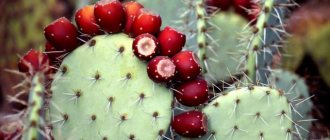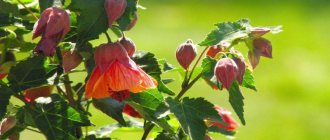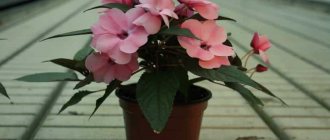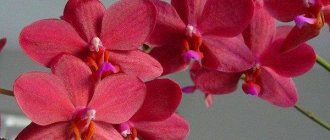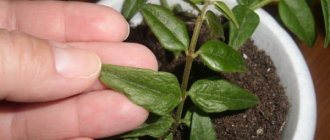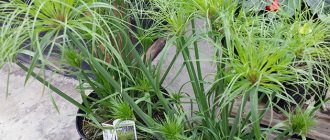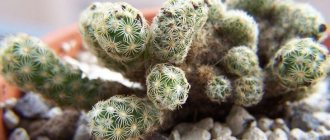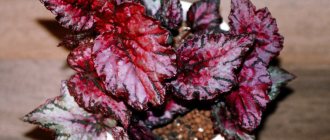In Soviet times, many people grew a strange plant on their windowsills - flat, fleshy cakes covered with sparse thorns. His name was simple - ears, mother-in-law's tongue. The “official” name is prickly pear. The cactus is not particularly beautiful. But during the flowering period, less diligent plant growers look at the wonderful flowers with envy. But few people have ever seen the fruits of prickly pear. They ripen at home very rarely. Is it easy to grow flowering prickly pear at home? Why does the cactus refuse to bloom? Is it possible to harvest prickly pear fruit?
Botanical description and geography of habitat
Prickly pear, scientific name Opuntia microdasys, belongs to the cactus family . The succulent is also called small-needle prickly pear due to the characteristics of the covering of the lobes - segments. The genus is numerous, there are more than 150 species.
Important! This variety grows well in apartment conditions.
The birthplace of the plant is considered to be Mexico, America, and the Galapagos Island. The species is widespread in southern Russia. The succulent grows naturally in tropical forests, deserts, and valleys. The plant was discovered in the 19th century by I. Lehman. This variety is a medium-sized cactus. It grows like a bush. The stem is highly branched and grows up to 50 cm in height. On the stems in the axils there are abundant buds - areoles. The whitish areoles have small glochidia and are golden-yellow in color.
The processes are round and oblong segments. The size of the shoots is average - up to 5 - 7 cm in length, dark green in color. The flowers are yellow with a golden tint. The stamens are small, filamentous. Flowering occurs in summer. The fruits have the shape of a red berry (find out more information about cactus fruits in this material).
We talked about the differences between prickly pear and agave here.
Popular types
Opuntia microdasys
Adult plants usually grow up to 50 cm. The shape of the cactus is traditional, and the stems themselves have a slightly dark green color. Golden spines look very good against this background. The flowers are usually medium in size and have a bright yellow color.
Prickly Pear / Flowering
Garden prickly pear (Opuntia)
This species received its name due to the fact that it can be safely planted in open ground without fear of winter frosts. The cactus can tolerate temperatures down to minus 30-35 degrees, but under a good layer of snow. If in your region the winters are not snowy, but frosty, then it is advisable to cover the plant with film.
Prickly pear Garden / Flowering
Indian prickly pear (Opuntia Ficus-indica) Fig
This species is also known as Opuntia fig . The plant grows quite tall. The shape of the stems is typical for Opuntia. The plant blooms profusely, after which it leaves a lot of tasty and juicy fruits, with a little pear and strawberry flavor.
Indian Prickly Pear / Flowering
Opuntia Bergeriana
Also quite a popular type, which has a slightly different shape. The stems are more elongated, light green with long spines. It blooms quite heavily. The flowers themselves are medium in size and red.
Berger's prickly pear / Bloom
White-haired prickly pear (Opuntia Leucotricha)
The most notable feature of this species is its long white hairs (spines). The plant is quite densely dotted with them, hence the name - white-haired. The cactus blooms with small, bright yellow flowers that emit a very pleasant smell, and after flowering, you can enjoy the delicious fruits.
Also read: Top 15 rare cacti. Unusual plants for the home!
White Haired Prickly Pear / Bloom
Common prickly pear (Opuntia vulgaris)
This type is often called classic and it is believed that all the others came from it. Plants grow up to 4-5 meters in height, but this is in their natural habitat. It is difficult to achieve such results at home. The stems are green, standard in shape, with a small number of spines. The cactus blooms with large yellow flowers.
Prickly Pear / Flowering
Opuntia Subulata
This species has the most atypical shape among the cacti presented here. The stem is long, slightly thick, and grows upward. Subsequently, the cactus grows quite strongly. Subulata flowers are small, pale pink in color, and during the flowering period there are quite a lot of them.
Prickly Pear Subulata / Flowering
Opuntia Main or Main (Opuntia Basilaris)
Another species that grows strongly, forming entire bushes. Unlike subulata, the shape of the cactus is traditional for Opuntia. The stems are quite often dotted with spines and have a light green color. During the flowering period, the plant produces quite a lot of medium-sized flowers, which can be of different colors - from bright pink to red.
Prickly pear Home / Flowering
Gosselin's prickly pear (Opuntia Gosseliniana)
Gosselina also grows and forms bushes. It blooms with bright yellow flowers, large in size, which smell very pleasant. Depending on the variety, the stems can be of two colors - green and bluish. In fact, there are no blue cacti; it’s all about the coating that forms on the surface. It has a characteristic color, which only gives the cactus a more exotic look.
Gosselin's Prickly Pear / Bloom
Photo
You will see a photo of the plant:
Useful properties of Opuntia Cactus
Prickly pear is not only a beautiful and hardy cactus, but also useful. Frost-resistant species of this plant are a natural antibiotic that can regulate and restore vital processes of the human body, including improving blood circulation.
If you drink Opuntia juice, you can get rid of hangover, headaches, and normalize blood pressure.
Prickly pear fruits contain a high fiber content, which helps reduce cholesterol levels in the body, and a sufficient amount of potassium leads to a decrease in blood pressure, relaxation of blood vessels and, accordingly, a decrease in the load on the cardiovascular system.
The magnesium content in Opuntia will help get rid of insomnia.
Traditional medicine recommends using the Opuntia Cactus to treat stomach ulcers. The fact is that the sticky substance and fibrous material contained in the cactus help slow down the development of stomach ulcers, and extracts from the leaves can reduce glucose levels after meals, which is especially important for patients with type 2 diabetes.
Conditions and care for home cultivation
Lighting
During the period of active growth, this cactus variety loves bright light, but direct exposure to the sun should be avoided. In the summer heat, light shading of the windows is required. In winter, the flower also consumes a lot of light. Additional lighting is required for 2 - 3 hours a day.
Watering
Water the plant sparingly, like all succulents. As the stem grows, the doses increase. In spring and summer, watering should be done once a week. In autumn, watering is reduced to once every 10–14 days. In winter, watering stops. The variety does not require additional spraying.
Attention! A warm shower is used to clean the leaves from dust. After the procedure, the plant is moved to a shady place until completely dry.
It is recommended to use only purified water for irrigation , acidified with several granules of citric acid. It is recommended to add water to the tray when watering so as not to compact the substrate.
Temperature
The temperature in summer is up to 20 – 27°C. In spring, the flower feels good at room temperature. The optimal air temperature in winter is 6 – 10°C.
Priming
The substrate should be moderately nutritious, loose, acidified, and light. You can purchase a ready-made mixture for cacti. At home, you can prepare the substrate yourself.
Soil composition:
- Turf soil – 1 hour.
- Leaf soil - 2 hours.
- Clay -1 tsp.
- Sand-1 tsp.
- Peat – 1 hour.
- Charcoal – 1 tsp.
- Humus – 1 hour.
Pot
For good growth, prickly pear should be planted in spacious, wide containers. Drainage holes are required at the bottom.
Important! To ensure stability of the pot, a drainage layer of 5–6 cm should be placed at the bottom.
It is better to use ceramic pots. Ceramics retain heat well and prevent roots from overcooling and overheating.
Trimming
When transplanting, pruning is required:
- Dry shoots are pruned.
- Deformed sections of the stem and diseased leaves are cut out.
- The root is cleaned of old, dry and rotten shoots.
- The sections are sprinkled with crushed charcoal.
- Strongly overgrown shoots that violate the shape of the crown should be pruned.
- Young trimmed fragments are used for cuttings.
Sloping, long branches should be tied up to form a beautiful bush.
Transfer
The plant is replanted after 2 - 3 years. Transplantation is carried out in the spring. The process is simple; you need to prepare the soil mixture in advance and disinfect the planting container.
Transplantation scheme:
- The plant is carefully dug out from the old pot.
- The roots are cleared of old soil.
- Sanitary pruning of the entire bush is carried out.
- The pot is treated with disinfectants and dried.
- The finished substrate is dried.
- Pieces of expanded clay and clay shards are placed at the bottom of the pot.
- The mixture is poured, the substrate is not compacted.
- The flower is buried at the root collar.
- The pots are installed in a place with diffused lighting.
During the week after planting, keep the seedlings dry.
Top dressing
The variety does not require regular fertilizing. In the spring and summer, complex mineral fertilizers are applied through watering once a month.
Find out more about caring for cacti in this material, learn about the types of cacti and their benefits and harms when growing in an apartment here.
How to grow a cactus at home
Prickly pear is a harsh plant, nature created it that way. But home cacti still need certain conditions and simple care.
One of the most important conditions is light and more light, remember prickly pear is a cactus. Place it on a south-facing windowsill, and provide additional lighting in winter. And one more thing - when buds begin to appear on the prickly pear, be careful. Do not rearrange or rotate the cactus, do not increase watering or fertilizing. This can lead to the degeneration of flower buds into vegetative ones.
Table: conditions for prickly pear
| Spring | preparation for growing season and flowering | Bright light, open sun, no shading. The best place for prickly pear is the south side. South-west, south-east will do. On the north side additional lighting is needed. Provide fresh air, ventilate the room and take the plant out onto the balcony. The temperature is moderate (20–25 degrees). |
| Summer | growing season and flowering period | Bright sun. The temperature is high, from +25 to +35 degrees above zero. On hot days, open the windows and move the plant to fresh air. No spraying required. When the buds appear, do not disturb the plant, do not move the pot, otherwise the buds may die or degenerate. |
| Autumn | entering a period of rest | The lighting is bright. Temperature is moderate. |
| Winter | rest period | The lighting is bright. Rotate the pot for even lighting. Place fluorescent lamps nearby. The temperature is cool (no higher than 15–18 degrees). Overheating negatively affects the shape and flowering of the plant. Protect from drafts. |
Features of planting in open ground
In southern and temperate climates, the plant can be planted in open ground.
Flower growers recommend placing the flower in a well-lit place, but closed from drafts. Drainage is required.
It should be planted on the tops of multi-tiered flower beds and hills so that water does not accumulate in the soil. The flower dies from excessive wetting.
Temperature and lighting
When deciding on a suitable location for a cactus, you should understand that the plant does not like frequent rearrangements, because of which it develops poorly. Prickly pear loves sunlight and well-ventilated places. She is not afraid of low temperatures. The only thing the cactus is afraid of is water. Overwatering is detrimental to it.
Prickly pear stores moisture in the foliage, so it is not afraid of long-term drought.
This type of cactus grows well on soils even with a slightly acidic reaction, which are not very fertile. It is important that the soil in the chosen location is loose and has good drainage. It would be a good idea to add pebbles or sand to the planting site so that the water does not stagnate and the cactus roots do not rot.
Temperature
If you grow a plant indoors, then in the summer it will feel comfortable in any part of the apartment, regardless of the weather. In the winter months, the optimal temperature for prickly pear should be 6-7 0 C, not higher. In the garden or on the lawn, the plant will survive in frosts of at least -10° C. If the winter is more severe, the prickly pear is covered with branches and fallen leaves.
Lighting
If your prickly pear is growing indoors, it needs to find a location with the bright sunlight it needs to grow well. You just need to “accustom” the plant to it gradually. If you plan to plant the cactus on the site, you will need to choose the most illuminated area that will be protected from the wind.
Reproduction
Seeds
Sowing of seeds is carried out in mid-March. The seeds should first be wiped with sandpaper due to their dense shell. The seeds are soaked in a weak solution of manganese for 2 - 3 hours.
Substrate composition: sand, activated carbon, leaf soil, in a ratio of 2:1:2. Before sowing, the substrate is calcined in the oven.
Sowing pattern:
- Small wide containers are filled with a layer of drainage and prepared substrate.
- The seeds are evenly distributed over the soil surface.
- The seeds are buried 1-2 cm.
- The crops are moistened.
- The containers are covered with film.
- Daily ventilation of the greenhouse is required.
- The substrate is sprayed with water as it dries.
- The seedlings are kept in the greenhouse for 3 – 4 weeks.
- Sprouts with 2 - 3 leaves are planted in small pots for growing.
Young shoots are grown for 2 years. Next comes transplanting into permanent pots.
Cuttings
Cuttings are carried out mainly in the spring.
Important! For propagation, a healthy young stem without flowers is used.
The cuttings are first sprinkled with charcoal and dried in a vertical position for 5–8 days until a dense film forms at the cut points.
Procedure for growing seedlings:
- The substrate is slightly moistened.
- The cuttings are installed shallowly in the container.
- The seedlings are covered with film.
- The containers are installed in a bright place.
- The air temperature for rooting is at least 20 °C.
- Rooting occurs quickly, after 2-3 weeks.
- Young shoots are transplanted into separate containers.
More details about the propagation of cacti can be found here.
Prickly pear diseases
Cacti are more susceptible to physiological - non-infectious diseases that develop under unfavorable conditions for plants. Stale air in a poorly ventilated area, high humidity in the air and soil, especially at low temperatures, contribute to the emergence and spread of diseases.
Main signs of ailments:
Brown spots on shoots. The reason is excessive watering.
The affected segments are cut down to healthy tissue and treated with crushed coal.
Shriveled leaves. This usually occurs due to lack of light or excess moisture.
It is recommended to move the plant to a brighter place and adjust watering.
Stopping growth. A consequence of excess moisture in winter and (or) deficiency of nutrients, including microelements.
Photo: pixabay.com
Proper watering and regular fertilizing will correct the situation.
Weakened plants can become infected with fungal diseases: blight (wet rot) and fomoz (dry rot). To protect against them, fungicides are used - Bordeaux mixture, Fundazol, Polychom (3).
Bloom
Prickly pear blooms in mid-summer. Flowering is numerous, up to 10 flowers are formed on one shoot. The flowers themselves are yellow with a lemon tint, the diameter of the flower reaches 4 - 5 cm. The duration of flowering depends on the conditions of detention, ranging from 1 to 3 weeks. It is difficult to achieve flowering at home; the plant requires greenhouse conditions.
To ripen the buds, the flower requires fresh air, a wide, voluminous pot, a sufficient amount of light, keeping the plant dry in winter, limited feeding, and a constant location of the pot without moving it. After flowering, flowers are removed only when the petals are completely dry.
Read more about cactus flowering here.
What does the plant look like and how does it bloom?
At home, prickly pear grows up to 1.5 m, but blooms rarely and reluctantly. There are also low-growing species from 15 to 30 cm.
- The stem is jointed, dark green. It consists of flattened shoots (cladodes) of a teardrop shape. At the top of the cladode, from 2 to 5 shoots grow - thus, the prickly pear branches in the form of a bush.
- The leaves are rudimentary, succulent, awl-shaped, up to 1 cm long, appearing in the areoles of young cladodes. They are pressed to the surface of the shoots and die off over time.
- The root system is superficial, fibrous.
- The flowers are funnel-shaped, single, multi-petaled, wide-open, from 3 to 6 cm in diameter. Colored in yellow, orange, red, pink and white. The stamens react to touch and immediately curl. Buds are formed along the edges of the cladodes. The flowering period is from April to August. In different species - from a week to 4 months. Only adult plants bloom from 4-5 years of age.
- The fruits are fleshy, weighing from 70 to 200 g, 5-12 cm long. They ripen from the end of July. The pulp is juicy, tender, watery. The consistency and taste is similar to ripe, sweet gooseberries and kiwi. Ripe fruits have pink-orange, red, and purple skin.
- All types of prickly pear, in addition to spines, have bundles of glochidia, which are located in the axillary buds of the stem and on the fruits.
Reference! Glochidia are barely noticeable, sharp, jagged bristles. When touched, they immediately penetrate into the skin and become fixed. They can only be removed with tweezers.
Briefly about diseases and pests
- Lack of light causes stunted growth and leaves become deformed.
- Increased air temperature during dormancy stops flowering and the stems become elongated.
- Due to dampness of the soil, drafts and cold, the substrate turns sour, the leaves dry out and fall off.
- Fungal infections are the most dangerous for this flower. The stem becomes brown, the entire bush becomes covered with mold. The reason is high humidity. The plant is discarded. Treatment of healthy flowers and substrate with a fungicide is required for prevention.
- An urgent plant transplant will help against root nematodes. The affected roots are cut off, the root is immersed in hot water for 5 - 10 minutes. The substrate and pot are sterilized.
- Timely treatment of the plant and soil with any insecticides will help prevent scale insects, aphids, spiderbugs, and other pests.
You can learn about diseases and pests of cacti in these materials.
Prickly pear pests
The main pests of prickly pear are spider mites and mealybugs; scale insects also readily settle on the shoots, and nematodes on the roots. Regular inspection of plants will allow you to immediately notice the appearance of pests and take action.
Spider mite. It multiplies quickly in dry, poorly ventilated areas. It feeds on plant cell sap, mainly on young shoots. With severe damage, prickly pears stop growing, and the color of the shoots changes to yellowish or reddish.
Acaricides are suitable for treatment: Neoron, Sunmite, etc. - according to the instructions.
Mealybug. When these small insects accumulate, the cacti seem to be sprinkled with flour. White lumps of oviposition are also clearly visible.
At the initial stage of infestation, insects and eggs can be washed off with a damp brush. Severely affected plants are treated with insecticides - Actellik, Fufanon (6), etc. and covered with plastic wrap for a day.
Against nematodes, the soil is watered twice, with an interval of 7–10 days, with nematicides (Vidat, Nematofagin-Mikopro, etc.), according to the instructions. Scale insects are mainly removed mechanically, and the shoots are then washed with a weak solution of potassium permanganate (3).
Interesting fact
In the recent past, in Mexico, entire prickly pear plantations were grown to breed the hairy aphid - cochineal, from which they obtained a valuable crimson dye - carmine. With the advent of synthetic dyes, the cultivation of cochineal has sharply decreased, but natural carmine is still used in the food and perfume industries, as well as in biochemical research and for staining histological preparations for study under a microscope.
Similar plants
- Prickly pear Sheri has the same round greenish segments as the fine-haired prickly pear. The flowers are pale yellow.
- White prickly pear blooms with large yellow flowers. The segments are densely strewn with setae and glochidia.
- Opuntia long-awned. The stem also consists of small green lobes covered with dense, short, thin needles.
- The Alba variety is a variety of small-haired prickly pear that grows as a compact bush. Short needles are densely planted over the entire surface of the plant.
- Sulfur-yellow prickly pear also has small lobes covered with thick light spines (read about how not to get pricked by a cactus and what to do if this happens). The plant is small, up to 40 cm in height.
Despite the fact that prickly pear is a desert flower, it requires careful and attentive treatment. Gentle light, moderate watering, careful feeding are necessary conditions for the growth and development of a flower.
Prickly pear - cactus care, watering, replanting, reproduction, problems
Homeland: North and South America.
Prickly pear is a fast-growing cactus. The stem has an oval, flattened shape; covered with spines - small gloxidia.
Flowers are yellow or red. In indoor culture it practically does not bloom.
The following species are cultivated in indoor culture: Opuntia microdasys, Opuntia microdasys var.albispina, Opuntia aciculate, Opuntia rufida, Opuntia vestita cristata, Opuntia bigelovii.
Lighting
- during the growing season (April/October) - before 12-00 and after 15-00 - direct sunlight;
- in autumn - winter - direct sunlight.
Acceptable lighting - per day, prickly pear requires at least 4 hours of direct sunlight.
Temperature
The minimum average winter temperature is + 5 0 C. At a temperature of +12 0 C and above, vegetative development begins. During the growing season, the optimal range for the development of prickly pear is:
- night temperatures +(18-21) 0 C;
- daytime temperatures +(24-30) 0 C.
When the temperature rises above +35 0 C, vital processes begin to slow down. At a temperature of +40 0 C and above, the prickly pear falls into a state of stagnation.
Air humidity
Optimal humidity is low.
Permissible humidity is moderate.
The humidity in our apartments is ideal for growing prickly pear.
Watering
- during the growing season (March / October) - after the earthen coma has completely dried;
- During the period of winter stagnation (November / February) we do not water.
Water for irrigation:
- optimally - settled rainwater or purified water (reverse osmosis);
- acceptable - settled water supply.
Fertilizer
We fertilize once during the growing season - at the end of March. To do this, we use fertilizer for cacti in the concentration recommended on the package.
More frequent fertilizing promotes vegetative growth, but at the same time, it is almost guaranteed that the prickly pear will not bloom.
Planting / replanting / choosing a pot
Transplantation is carried out at least once every two years. Replanting prickly pear every year will stimulate high rates of vegetative growth. Transplant time: spring/summer or after flowering.
Composition of the soil mixture for growing most types of prickly pear: 1 part turf soil + 1 part leaf soil + 2 parts perlite or coarse sand + 10% charcoal + 10% brick chips + 10% sphagnum moss + 10g bone meal (for every 10 liters of mixture) . The specified composition is universal. For some types of prickly pear, 5-6 g of lime is added to the composition (per 10 liters of mixture).
Problems arising from violation of containment conditions
1) The stem wrinkles, the “ears” droop (during the growing season).
The reason is dehydration of the plant, too long intervals between waterings. The problem is typical for the summer period; worsens if the plant has “outgrown” its pot and (or) midday sun rays overheat it.
2) The lower part of the stem is covered with cork fabric.
- if the old part of the plant (more than 2 years old) is covered with a “cork”, then this is a natural process;
- If young growths are covered with a “plug”, then the cause is dirt. The most common mistake plant growers make is that when watering a cactus, water gets on the stem. Considering that in most cases the water for irrigation is hard, when it dries, the salt particles clog the pores of the stem and lead to premature “aging” of the plant tissue. The second most important mistake is that a stream of water dislodges dirt particles from the surface of the substrate, which fall on the cactus stem, which also leads to premature “aging” of the plant tissue.
3) Prickly pear does not grow during the growing season.
Reason: damaged root system (improper watering); The main driver of vegetative growth for most prickly pear species is a combination of heat and good lighting - other factors are secondary.
4) From the side of the light source (sun), a large straw-colored spot appears on the stem.
The cause is sunburn. Prickly pears are resistant to sunlight. Sunburn occurs in rare cases when a plant from a shaded place is exposed to the open air under direct sunlight. Conclusion: before a sharp change in the illumination level, an adaptation period (2 weeks) is required, during which the illumination will increase gradually.
5) The prickly pear has bent or the stem has fallen and/or its lower part is covered with spots (orange, brown or black); Rotting of the stem and roots is possible.
The reason is excessive watering. Prickly pear does not tolerate frequent watering. It is possible that water stagnates in the pot if the drainage hole is clogged; or the cactus was exposed to prolonged rains (when kept outdoors).
6) Cracks form on the prickly pear stem.
The reason is frequent watering.
7) In winter, prickly pear begins to shrink.
The reason is the high temperature of the content. It is necessary to carry out one-time top watering. It is advisable to bring the winter temperature in line with the recommended temperature.
Light brown spots appear on the surface of the stems (during cold periods).
The reason is exposure to low temperatures.
Disease of infectious origin
Anthracnose. Signs: the affected areas of the stem appear light brown in color and are moist to the touch. Pink spores are visible on the surface of the lesion.
There is no treatment - the plant, along with the pot and soil, is disposed of. The remaining plants and equipment are treated with copper-containing preparations. Subsequently, it is necessary to create conditions unfavorable for the development of the disease (more details about the disease are described in the article “Anthracnose”). The main source of infection of indoor plants is the use of unsterilized soil mixtures when planting or replanting cacti.
Pests
In indoor culture, the mealybug is the most common.
If you brought a cactus taken from the wild or from a tourist trip, then the range of pests can be huge: scale insects, nematodes, various types of fleas, spiders, slugs, snails - in this case it is necessary to correctly identify the “villain” , and then determine a method of dealing with it, if necessary. Why, if necessary? – many “moving organisms” do not feed on prickly pear, but use it as a home.
Photo gallery
They can be oblong or obovate, thick. These parts of the plant grow from one another and are somewhat reminiscent of cakes. The color of the stems usually varies in dark green tones. Young shoots have rudimentary leaves that fall off over time. The leaves are small but juicy and have a bright green color. On the shoots in the areoles, white glochidia spines are densely located in bunches. They have curved tips that are difficult to notice with the naked eye. The spines are very thin and break easily, so with any careless touch they get under the skin and can cause irritation.
Some species of prickly pear have edible fruits. They usually ripen from mid-July to mid-August. The outside of the fruit is covered with scales and small bunches of evenly distributed spines. The ovaries, which are green at first, grow in size over time and change color to bright burgundy.
The fruits are fleshy and can be quite large in size - from 5 to 10 cm in length. Their weight varies between 70 - 100 g. The pulp is translucent, whitish, and sweet in taste.
The plant can produce new shoots and flowers directly from the fruits.
Prickly pear shoots have beneficial properties. They contain sugar, starch, vitamin C and protein. Therefore, the cactus is used to feed animals. And in some regions of America, local residents use edible plant species as food. Alcoholic drinks, jam, desserts, etc. are prepared from prickly pear fruits.
